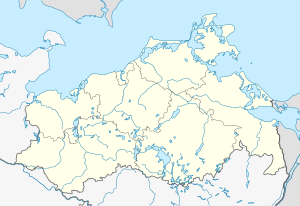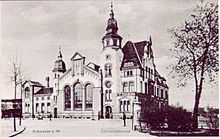Municipal power station (Schwerin)
| Municipal electricity company | |||
|---|---|---|---|
| Municipal power station in Schwerin | |||
| location | |||
|
|
|||
| Coordinates | 53 ° 38 '11 " N , 11 ° 24' 52" E | ||
| country |
|
||
| Data | |||
| Type | Motor power plant | ||
| operator | VEB Energy Supply Schwerin (1969) | ||
| Project start | 1901 | ||
| Start of operations | 1904 | ||
| Shutdown | 1969 | ||
| turbine |
Gas engines (until 1926) Diesel engines (initially additional, from 1926 exclusively) |
||
The former municipal power station (also: E-Werk Schwerin ) on the north-east bank of the Pfaffenteich in the city of Schwerin was used to produce electricity from 1904 to 1969 and was in operation as a switchgear in the municipal power grid until 1999. The listed building has been used culturally since 1998 - as a venue for the state theater , the puppet stage , the Fritz Reuter stage and for the Schwerin Art Association.
Building
The picturesque and multi-shaped brick plaster building located on the Spieltordamm between the Pfaffenteich and the Ziegelsee was built in 1903/04 in the German Renaissance style with a machine hall and administration wing. Due to the towers and the elaborate facade design, the power station has a castle-like character. Address: Spieltordamm 5.
history
After electric lighting had been gradually introduced in the capital of Berlin since 1882, the transfer of a thirty-year power supply monopoly to the Deutsche Edison Gesellschaft in Schwerin failed at the Ministry of the Interior in 1884, which feared that private consumption would become more expensive. In the years that followed, Senator Lisch, the son of Georg Christian Friedrich Lisch, tried to advance the development in this area for Schwerin through reports on the introduction of electrical lighting in other cities and applications for the assumption of costs for business trips to gain knowledge. However, these applications were rejected several times and the majority of the citizens' committee decided to wait for the technical development. Only with the installation of small machines for power supply by tradespeople, merchants and at the court theater, as well as a survey among the people of Schwerin who expressed an interest in a power supply, did the citizens' committee decide in 1901 to build a power station.
Before the construction, the Berlin electrical engineer and engineer Georg Klingenberg was entrusted with the preparation of a construction and profitability report. Due to the cheaper production and the possibility of an uncomplicated tram operation , a decision was made, contrary to the wishes of the expert Lisch, for direct current operation . This was also supported by the fact that the technology in this area was more mature at the time and that direct current could be stored, which did not require continuous operation. As in the past, direct current, unlike high-voltage alternating current, could not be transported over long distances, the construction of the supply works in the middle of the city was necessary.
Although there were concerns about the strength of the building site, the previously undeveloped area on the Spieltordamm was chosen. AEG Berlin was commissioned with the construction of the power plant financed by bonds . In order not to spoil the cityscape, instead of a steam engine , which would have required a chimney, gas engines were installed and the building was designed in such a way that it blended in harmoniously with the cityscape and its purpose could not be seen from the outside. The construction department took over the constructional part of the project, AEG was responsible for the project development. The Gebr. Körting AG took over the supply and installation of the machines.
Trial operations began in November 1904, initially several explosions and accidents occurred, which damaged the reputation of the power station. Residents also complained about the smell of gas and machine noise. The gas used as fuel was obtained from the gasification of hard coal. A machine failure on December 4, 1904 caused a temporary shutdown. Regular operation started on December 24th of the same year. The initial equipment of the electricity company included:
- two gas generators with an output of 350 hp each
- Suction gas engines
- two 220 kW DC shunt dynamo machines
- Battery consisting of 268 elements (in the basement) with a capacity of 972 Ah, which is sufficient for three hours with an output of 150 kW
The power station, which was intended for the lighting of private households and the operation of the tram, supplied 1,225 households by 1910. Most of the street lighting was initially carried out by gas lamps. In contrast to cities like Wismar and Rostock , Schwerin did not transfer the power supply to large electricity companies until 1935. Electricity could be produced more cheaply than it was bought, and annual surpluses were a welcome side effect.
Over the years the demand for electricity increased and expansions followed. In 1908, the electric tram became a major customer. The direct current network was unsuitable for supplying more distant parts of the city and surrounding places to improve the utilization of the power plant. These had to be supplied with alternating current. Due to a lack of personnel and materials, the machines were in poor condition at the end of the First World War, and some of them were defective. A lack of coal meant that from December 1, 1918 to April 1, 1919, trams were shut down.
| 1929 | 1932 | 1933 | 1934 | |
|---|---|---|---|---|
| Generation (million kWh) | 5.99 | 6.2 | 6.99 | 8.19 |
| Usable tax (million kWh) | 4.98 | 5.01 | 5.91 | 7.01 |
| Connection value (approx. KW) | 11,600 | 14,300 | 16,000 | 18,000 |
In 1921 the Städtische Elektrizitätswerke concluded an electricity supply contract with the Mecklenburgisch-Schwerin'schen Electrizitätswerke (LEW). Deliveries to the LEW network took place from 1921 to 1925, then again from 1930/31. After the machine park was supplemented with diesel engines over time, the plant was completely converted to diesel operation between 1921 and 1926. In 1928 the machine output was 7000 hp and the generator output 4700 kW. From November 1924, the waste heat from the diesel engines was used for a small hot water district heating network at Pfaffenteich. Some engines were converted to run on coal tar in the 1930s .
With the construction of a large power plant in Brandenburg for the Märkisches Elektricitätswerk (MEW), a supplier that supplied almost all of Brandenburg, Mecklenburg and Pomerania in the early 1930s, the pressure on the small but profitable electrical plant in Schwerin increased due to takeover attempts. Only after the diesel became more expensive due to higher tariffs and the increased demand for electricity was an electricity supply contract concluded with MEW to cover the base load . The plant at Pfaffenteich was only used from October to February from 6 a.m. to 8 a.m. and from 4 p.m. to 10 p.m. to cover peak consumption.
After the Second World War, the growing population's demand for electricity continued to increase, but it could not be met, and power cuts were the result until 1953. During this time, the share of energy produced by the municipal electrical works was 35 to 40 percent. In 1969, with the security of the power supply through interconnected networks, electricity production with the now scrap-ripe electrical equipment was stopped. Only an emergency power system remained and a transformer repair shop subsequently used the facility's premises. In 1969 a high-voltage switchgear was installed and the supply in the city center was completely switched to alternating current. The switchgear was operated by the Schwerin municipal utility until 1999 . Since 1998, the E-Werk has been used culturally as a venue for the state theater , the puppet stage and the Fritz Reuter stage.
Today, the local energy provider uses two modern, gas-powered combined heat and power plants in the Wüstmark and Lankow districts to generate electricity ( see also: Schwerin-Süd combined heat and power plant and Schwerin-Lankow combined heat and power plant ).
literature
- May Hempel, Ingo Sens, Ed .: Stadtwerke Schwerin: 100 Years of Public Power Supply in Schwerin , Maxpress Verlag, Schwerin 2004
Web links
Individual evidence
- ^ A b c State capital Schwerin (ed.): City guide. Data, facts, figures and a street directory. 4th edition, 2006, p. 17
- ↑ a b Sign on the building
- ↑ Mecklenburg-Western Pomerania Monument List (as of 1997) on landtag-mv.de, p. 382 (PDF; 956 kB)
- ^ Georg Dehio: Handbook of German Art Monuments. Mecklenburg-Western Pomerania , Deutscher Kunstverlag, revision, Munich / Berlin 2000, ISBN 3-422-03081-6
- ↑ a b c d e f g Bernd Kasten and Jens-Uwe Rost: Schwerin. History of the city. Thomas Helms Verlag, Schwerin 2005. ISBN 3-935749-38-4 , pp. 137ff.
- ↑ a b c d e May Hempel, Ingo Sens: 100 Years of Public Power Supply in Schwerin , Maxpress Verlag, Schwerin 2004
- ↑ KASTEN / ROST P. 273





